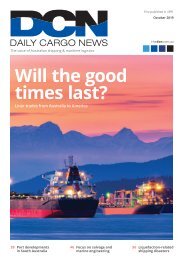DCN0718_Combined_150
Create successful ePaper yourself
Turn your PDF publications into a flip-book with our unique Google optimized e-Paper software.
THE BROKER’S VIEW<br />
Talking trade with<br />
the CBFCA<br />
Customs Brokers and Forwarders Council of Australia chief executive<br />
Paul Damkjaer outlines some key talking points<br />
THE CBFCA HAS CONDUCTED<br />
demonstrations of its new electronic<br />
tariff, with great reviews from members.<br />
It is a competitive product for members’<br />
classification needs, whether they<br />
be imports or exports. It is an everevolving<br />
software product to be updated<br />
as we receive member requests. With<br />
it currently in test mode, where it is<br />
available to all members for free, it is to<br />
be officially launched on 1 July 2018.<br />
REGULATORY ENGAGEMENT<br />
While the Department of Home<br />
Affairs and the Australian Border Force<br />
regularly talk of industry engagement,<br />
this only seems to be happening at a<br />
senior management level. Involvement<br />
at this level is welcomed by the CBFCA.<br />
However, it is at the operational day-today<br />
level where improvement is required.<br />
Industry stakeholders trying to resolve<br />
issues in relation to current shipments,<br />
refunds and valuation regularly find<br />
themselves referred from department<br />
to department, receiving email auto<br />
responses. These stakeholders should<br />
have a direct link to the ABF to be able<br />
to find an officer able to resolve the<br />
issue at hand. Border and community<br />
protection is a shared responsibility<br />
and the ABF needs to consider improving<br />
its interface and industry’s access to<br />
skilled officers.<br />
While the CBFCA has obtained a<br />
high-level organisation chart, it is short<br />
of the contacts needed for industry to<br />
run successful businesses. The CBFCA<br />
will continue to seek an operational-level<br />
contact list for members.<br />
GST ON LOW-VALUE THRESHOLD<br />
GOODS<br />
While industry has seen various<br />
communications from the ABF and the<br />
Australian Tax Office, it is fair to say<br />
there are still many within industry who<br />
are confused. At the recent round of<br />
regional CBFCA conventions, the ATO<br />
gave presentations that went some way<br />
towards easing members’ concerns. It<br />
was made quite clear the ATO’s follow-up<br />
actions would be towards the overseas<br />
entity, however the ABF presentation still<br />
leaves members concerned of potential<br />
penalty action down the track.<br />
The ABF provided screen shots of<br />
FIDs and SACs, and advised that should<br />
industry not have the necessary evidence<br />
of GST having been paid at the point<br />
of sale or a VIN, they should process<br />
the clearance in the normal way. It is<br />
then up to the ATO to follow-up noncollection<br />
at the point of sale overseas.<br />
The CBFCA will continue to represent<br />
members concerns to both the ATO and<br />
ABF and work to ensure the protection of<br />
members in this area.<br />
BMSB POST-SEASON REVIEW<br />
DAWR is undertaking a review of the<br />
brown marmorated stink bug (BMSB)<br />
risk season and currently working<br />
with industry to identify performance<br />
improvements for season 2018-19.<br />
The emergency measures applied to<br />
the 2017/2018 BMSB season challenged<br />
the Department and industry with<br />
the facilitation of trade at the border<br />
resulting in extended delays in cargo<br />
clearance and additional costs.<br />
For next season’s measures, the<br />
Department is expected to use the<br />
experiences and data from the recent<br />
season to prepare a BMSB management<br />
strategy for next season.<br />
The CBFCA will continue to consult<br />
with the department on any proposed<br />
measures prior to the commencement of<br />
the next BMSB risk season.<br />
THE OMBUDSMAN<br />
The Commonwealth Ombudsman<br />
has released a report into processing<br />
delays for inbound containerised sea<br />
cargo. In May 2017 the Ombudsman’s<br />
Above: Paul Damkjaer,<br />
chief executive, CBFCA<br />
office started an investigation into the<br />
administration of powers under the<br />
Customs Act 1901 by the then ABF.<br />
The CBFCA had raised concerns about<br />
unnecessary delays stemming from the<br />
ABF’s administration of its customsrelated<br />
powers.<br />
Since July 2012, the office has received<br />
356 approaches related to the border<br />
control area of the ABF.<br />
The report lists recommendations<br />
which address many of the concerns<br />
CBFCA and industry have raised in<br />
regards staffing levels, processing times,<br />
infrastructure, the ability for clear<br />
communication and a clearly detailed<br />
compensation process.<br />
The CBFCA is pleased with the<br />
reception by the Ombudsman and<br />
looks forward to working closely with<br />
the ABF to assist in putting in place its<br />
recommendations.<br />
The Ombudsman will engage in<br />
further discussions with the CBFCA on<br />
the progress of these recommendations<br />
and will also seek a combined meeting<br />
with other key stakeholders.<br />
Ian Ackerman<br />
22<br />
First published in 1891<br />
July 2018<br />
thedcn.com.au

















